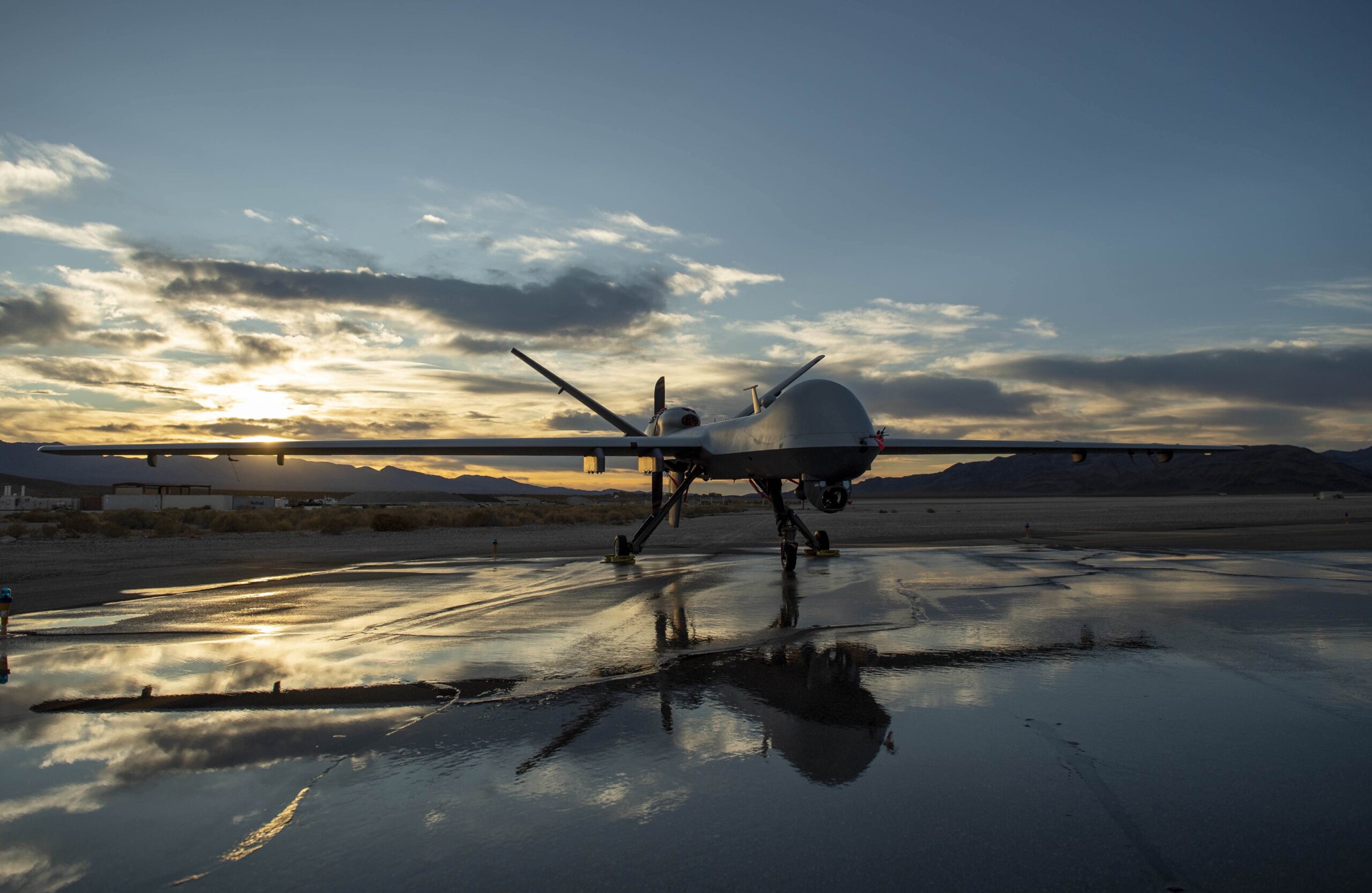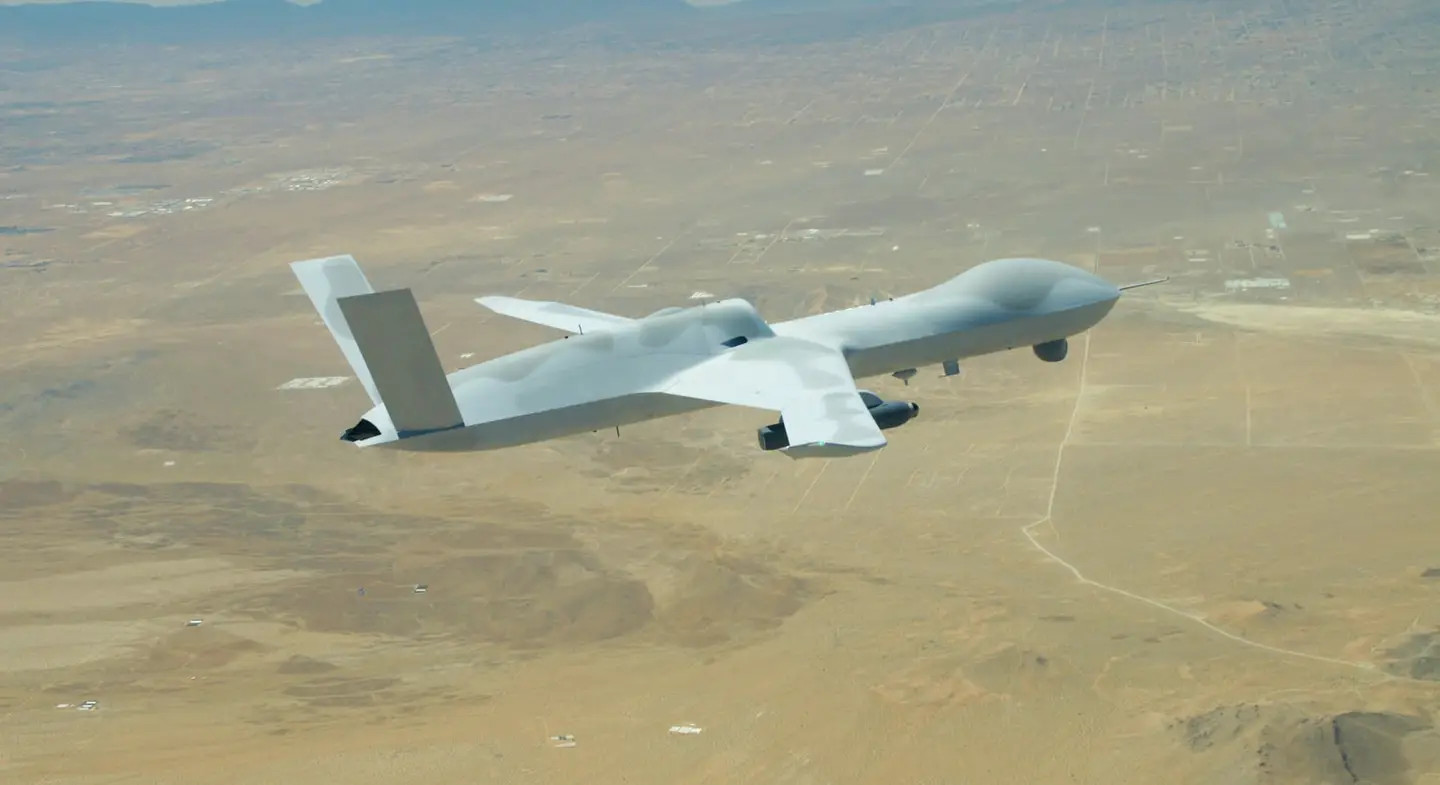Using its somewhat stealthy MQ-20 Avenger, General Atomics Aeronautical Systems (GA-ASI) has begun flight demonstrations of a system it’s developed that will allow small drones to be launched and recovered in mid-air from larger uncrewed aerial vehicles. It’s part of a broader vision for how these kinds of aircraft might be employed in future conflicts.
The concept is known to the company as the Aerial Recovery System for Small Unmanned Aircraft Systems/Air-Launched Effects (SUAS/ALE), and you can read more about it here. Until now, however, it had been associated primarily with the non-stealthy GA-ASI MQ-9 Reaper and MQ-1C Gray Eagle.
A media release today from GA-ASI reveals that a system demonstration took place over the Dugway Proving Ground, Utah, on September 20, 2023. This saw a towline deployed and retracted from one of the company’s larger Extended Range version of the jet-powered Avenger.

The towline itself was fitted with what GA-ASI describes as a “smart end feature,” which includes a wireless link with the larger drone mothership.
GA-ASI provided the following details about the trial:
“During this demonstration, a hoist from Breeze-Eastern equipped with GA-ASI’s smart end feature was integrated into Avenger’s payload bay. While in flight, the towline was deployed away from Avenger to the optimal distance for aerial recovery. The smart end feature was able to wirelessly transmit its position back to Avenger, confirming its ability to transmit the data to a nearby SUAS/ALE for aerial recovery.”
The smart end feature not only serves as a mechanical interface for aerial launch/recovery of a drone but also includes a beacon, providing cues as to where it is relative to the smaller drone. Originally, GA-ASI designed this concept specifically around launching and recovering its own Sparrowhawk drone, but the company now seems to be suggesting that it could be utilized with other drones, too.

In terms of how it works, the SUAS/ALE drone can calculate its exact position relative to the smart end feature. Once it has flown to the towline, it flies a maneuver to capture the end feature. When it is secure on the towline, the SUAS/ALE folds its wings and switches its engine off. It can then be reeled into the mothership drone using a podded hoist.
“Integrating air-launched UAS from Group 5 unmanned aircraft is possible, in part, thanks to advances in relative navigation technology, complex towline analysis, and multi-aircraft control being pioneered by GA-ASI,” said Mike Atwood, Vice President of Advanced Programs at GA-ASI. “We are excited to see this technology enable long-range kill chains from today’s manned and unmanned systems supporting operations in highly contested environments.”
In this context, Group 5 drones weigh more than 1,320 pounds and typically operate higher than 18,000 feet, at any speed. This category includes GA-ASI’s MQ-9 Reaper and MQ-1C Gray Eagle, as well as the Avenger, as used in this recent trial of the launch and recovery system.

While the latest media release from GA-ASI doesn’t actually provide specific details of the SUAS/ALE drone, or drones, that will eventually be used, a tweet from the company today states that the system “will enable our large unmanned aircraft to recover and redeploy smaller ones, like Sparrowhawk, midflight.” The computer simulation also shows a Sparrowhawk drone being launched and recovered from an Avenger, as seen below:
The Sparrowhawk is a small drone specifically designed to be launched and recovered in mid-air and you can read more about it here.

The Sparrowhawk drone features a large main wing that is stowed parallel with the main fuselage before launch, after which it swings 90 degrees into a deployed position. The drone also has a v-tail and more recent concept art shows externally-mounted engines within annular nacelles.


While the SUAS/ALE experiments have not, so far, involved a small drone being launched from the larger mothership, or retrieved in flight, the concept ultimately promises to offer much more than the capability to release a drone and then capture it in mid-air and bring it back to base.
Once the concept is fully realized, the smaller SUAS/ALE should be able to be refueled, recharged, and rearmed, before being redeployed, according to General Atomics. However, it is by no means clear how a drone like the Avenger or even a Reaper would rearm as smaller drone in flight. These future developments are more in line with talk about using larger motherships, including crewed aircraft. But if recharging/refueling is possible, the same SUAS/ALE drone would be able to undertake multiple sorties in the course of a single mission flown by the mothership, with its longer endurance.

Expanding the concept, GA-ASI also plans to work toward Avenger or Reaper drones serving as “mobile command centers” for a network of SUAS/ALEs in a “persistent, expansive grid.” Missions undertaken by these drone teams would include surveillance, electronic attack, suppression of enemy air defenses, establishing communication pathways, as well as joint all-domain mobile command and control.
Furthermore, while the endurance of the Avenger or Reaper drones launching and recovering the SUAS/ALEs would be limited, the smaller drones would potentially be able to remain on station for “days or weeks at a time,” being picked up by other motherships as they arrive in the area. The larger drones would provide them with a more or less constant supply of fuel, battery power, and weapons (if that is actually feasible), as required.
Back in 2021, before the Avenger was being openly offered as part of the concept, C. Mark Brinkley, the Director of Strategic Communications & Marketing at GA-ASI, laid out to The War Zone a typical scenario as to how the SUAS/ALE might be used:
“Our larger [uncrewed] aircraft can transport these small UAS systems thousands of miles into the operational area, and provide the long-range sensors needed to identify potential targets of opportunity. Once identified, the small UAS can swoop in for a closer look, provide positive ID, and then track hostile actors. That data is passed back to the MQ-9 or MQ-1C, which has the robust communications suite necessary to transmit that data anywhere in the world where the information is needed. As a team, the large/small UAS combo will be a key element for targeting, intelligence, reconnaissance, and networking across the future combat spectrum.”
As to potential alternative SUAS/ALE payloads, GA-ASI in 2021 released concept art of another small drone design designed to be launched in mid-air from a Reaper-sized drone. This unnamed drone features a v-tail and a pop-out wing configuration like the Sparrowhawk but has a different propulsion system, with a front-mounted propeller.

This drone was described as being part of a larger “family of small UAS,” which also includes the aforementioned Sparrowhawk.
In the past, GA-ASI has also tested its Gray Eagle drone as a launch platform for the Agile-Launch Tactically Integrated Unmanned System (ALTIUS) 600 drone. The U.S. Army has been actively using the ALTIUS 600 as part of its own Air Launch Effects (ALE) program.

Much like General Atomics’ Air-Launched Effects program, the Army’s own ALE program plans to develop a family of smaller drones that can be launched from larger manned or unmanned aircraft and that are capable of working together as networked swarms to perform various missions, including intelligence, surveillance, and reconnaissance (ISR), electronic attack, decoy, and strike. You can read more about the Army ALE effort here.
The Air Force, too, has been exploring the use of the ALTIUS-600 in air-launched mode, with at least one of these drones having been dropped from an XQ-58A Valkyrie’s internal payload bay.
The ALTIUS-600 is not intended to be recovered while in flight by another aircraft though.

Whatever the types of SUAS/ALE drones that GA-ASI will involve in the later stages of its Aerial Recovery System testing, it’s important to note that the concept is very much expected to yield solutions for high-end types of conflict, in particular.
While the survivability of drones like the MQ-9s and MQ-1Cs might be questionable even in fairly permissive airspace, let alone future contested environments, the ability for them to launch and recover smaller drones is seen as critical to ensuring they can still play a role in those kinds of scenarios.

“By employing these smaller UAS, Reaper and Gray Eagle operators will be able to penetrate, disintegrate and exploit anti-access and area denial (A2/AD) air defenses, and support operations in any domain,” GA-ASI told The War Zone in 2021. “Meanwhile, the greater standoff afforded by these smaller UAS increases the survivability of the larger aircraft by placing them outside the kinetic range of tactical surface-to-air missiles.”
At the same time, the U.S. military is looking at other ways to make drones like the Reaper and Gray Eagle more survivable, including a new self-protection pod with built-in radar warning receivers, a Distributed Aperture Infrared Countermeasure (DAIRCM) system, plus a countermeasures dispenser that can release decoy flares, chaff, and the BriteCloud expandable radio-frequency decoy.

However, with the latest test migrating the Aerial Recovery System for SUAS/ALE drones to the stealthy MQ-20 Avenger drone, the survivability of the mothership, and the potential capabilities of the system as a whole, are increased by an order of magnitude. Having the Avenger as a platform for SUAS/ALE opens up a whole new set of possible missions for the concept, far beyond finding new roles for non-stealthy Reapers and similar, by using them to launch smaller drones from outside the reach of enemy defenses. Being more survivable, an Avenger could conceivably launch and recover smaller drones in somewhat higher-risk environments.
While GA-ASI may be just at the start of its exploration of the launch and recovery of small drones from larger ones, the company is clearly pinning many hopes on the concept and what it could offer the U.S. military in future conflict scenarios. Still, many hurdles remain, but it will be interesting to see how General Atomics moves the concept along.
Contact the author: thomas@thedrive.com
